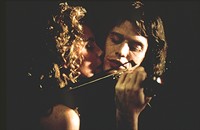
The opening moments introduce us to the studio of Nicolo
Bussoti, a world of alchemy where magic and music are molded
together into one form. The instruments must be perfect in
order to insure the music will have a superior tone.
Unreservedly, we follow the causeway demanded by the fates
and fortunes of a red violin. The voice of this particular
instrument becomes only truly clarified when we finally
discover, approaching the end of the tale, the reason why it
breathes so delicately and possesses such a penetrating
sound, at least for those who are equipped to recognize its
mystical qualities.
The Red Violin
© RCV Film Distribution BV

|
This gothic history spans three centuries that, joined together,
reveal its hidden secret which has for so long has been buried
away, time and again, in one way or another, only to be
resurrected and take its present place of honor. Its mysterious
beauty is overwhelming and its charm is more ominous than
that of the Hope diamond. Its deepest secret cannot be
revealed in these passages; for that you will have to see the
movie.
Director Francois Girard has created a fascinating series of
diverse episodes that convey us through a sedate, but turbulent
world filled with quiet passions and intense feelings. The
transcending element in each is the instrument that survives
triumphantly the short lives surrounding it. Each period is
punctuated by the story of one owner whose life was influenced
by the presence of the red violin. Shot in five languages over a
period of six months, the movie is a symphony of world sounds
and images.
Busotti (Carlo Cecchi), the violinmaker, creates his masterpiece
shortly before his wife (Irene Grazioli) dies in childbirth. Like a
man possessed, he turns this instrument into the renowned red
violin, which must remain an everlasting tribute imbued with the
spirit of his lost wife and child. Once away from home, the
violin begins its journey inside an Austrian monastery winding
up in the hands of the young, talented child, Kasper Weiss
(Christoph Koncz) in 1792. Shortly afterwards, the violin is
buried away until it is retrieved by a band of roving gypsies.
In 1893, the strains of the chords are heard by composer and
violinist Frederick Pope (Jason Fleming) who manages to
become the next owner and fiddle wildly like the devil on a
spree. Pope's unorthodox lifestyle includes, among other
indulgences, a temperamental relationship with the novelist
Victoria Byrd (Greta Scacchi) which is destined to end with an
even more distant voyage for the red violin. This one
commences when Pope's Chinese manservant (Stuart Ong),
who counted the frequent supplying of cherished opium to his
ex-employer among his duties, secretly carries the instrument
off to a pawnbroker in Shanghai. Eventually, it is purchased by
a woman who leaves it to her daughter, who will be forced, as a
grown woman (Xiang Pei) to hide her musical treasure away
during the Chinese Cultural Revolution.
Years after the
Revolution ends, the violin is sent to Montreal where an expert
called Charles Morritz (Samuel L. Jackson) is busy appraising
its value for auction. And with this the tale begins to come full
circle. From one hand to another, the red violin has traveled
from maker to child to gypsy to composer to activist to
auctioneer and from Italy to Austria to England to China and,
finally, to Montreal. But, even after arrival in Canada, its
travels seem to be far from ended.
All of the actors perform elegantly, sharing the screen
respectfully with their partners without attempting to outshine
one another, which is befitting to a piece with many
compositions. The score is beautiful, but remains polite in
never taking a disturbing precedence over the entire scope of
the production.
Perhaps you question whether this story is based upon fact.
Well, haven't you ever heard of the noted 17th century
violinmaker Bussoti?
© 1994-2006 The Green Hartnett
|

